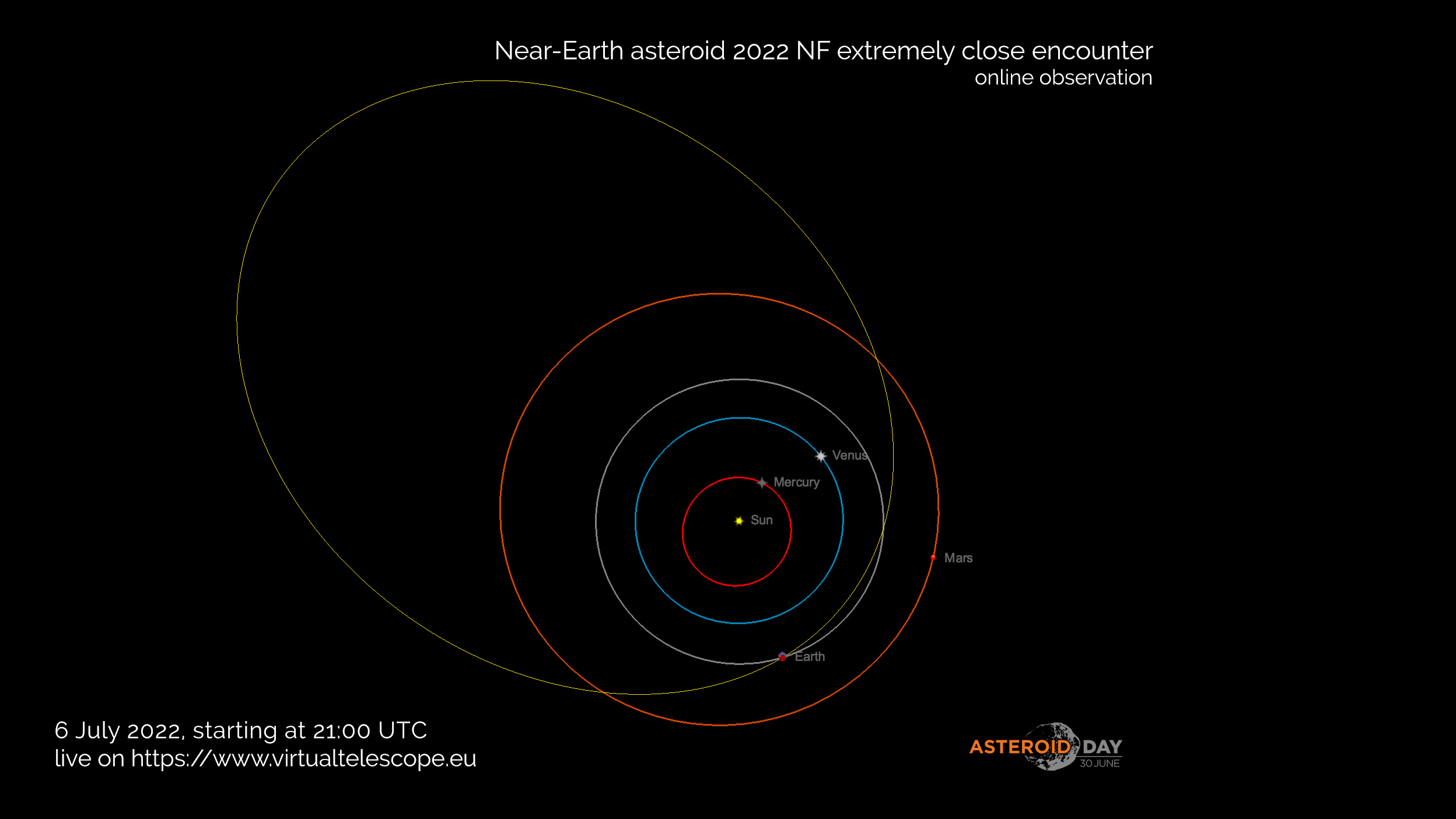A bus-sized asteroid is passing safely by Earth today and you can watch for free
The webcast starts Wednesday (July 6) at 4 p.m. ET.
A space rock at least the size of a bus will safely whiz by our planet today, and you can watch the event on a free livestream.
The Virtual Telescope Project will broadcast the flyby of asteroid 2022 NF from Rome, Italy, where the project is situated. If weather conditions allow, you can watch the livestream starting at 4 p.m. EDT (2100 GMT) in the window above or directly from the Virtual Telescope Project.
At a nearest approach of 56,000 miles (90,000 kilometers), 2022 NF will come within about 23% of the distance to our moon. That's close in celestial terms, but still a very safe distance for Earth.
Related: Just how many threatening asteroids are there? It's complicated.
The flyby event is the project's tribute to 2022's Asteroid Day, according to Virtual Telescope Project founder Gianluca Masi. Asteroid Day is an Asteroid Foundation annual promotion of space rocks and planetary defense research that takes place on June 30.
The space rock, first spotted in 2022, is at its longest dimension between 18 feet and 41 feet (5.5 meters and 12.5 meters). That's at least bus-sized, although the asteroid could range as large as a shipping container.
That size means that, technically speaking, 2022 NF is not classified as a "potentially hazardous asteroid" (PHA) by the metrics used by NASA's Jet Propulsion Laboratory (JPL) in California.
Get the Space.com Newsletter
Breaking space news, the latest updates on rocket launches, skywatching events and more!

While the asteroid will come well within the required 4.6 million miles (7.5 million km) of Earth to qualify as a PHA, its small size is well under the generally accepted 460 feet (140 meters) that also forms this designation. The size, however, is an approximation as usually we can only assess asteroids by their brightness, a proxy for size.
As a note, "potentially hazardous" is not meant to be a formal assessment of the likelihood or danger of an asteroid hitting the Earth, and how hazard is determined is complicated.
The asteroid circles the sun about every six years, according to JPL's Small-Body Database, where you can look up any asteroid ever tracked by professional telescopes. You can also see 2022 NF on JPL's list of upcoming close asteroid approaches.
NASA and a network of partner telescopes regularly monitor the sky for small bodies like 2022 NF and have found no imminent threats to worry about, although they keep searching and working on planetary defense technologies as a precaution.
If you're looking for binoculars or a telescope to see the asteroid in the night sky, check out our guide for the best binocular deals and the best telescope deals now. If you need equipment to capture the moment, consider our guides for the best cameras for astrophotography and the best lenses for astrophotography to make sure you're ready for the next asteroid sighting.
Follow Elizabeth Howell on Twitter @howellspace. Follow us on Twitter @Spacedotcom and on Facebook.
Join our Space Forums to keep talking space on the latest missions, night sky and more! And if you have a news tip, correction or comment, let us know at: community@space.com.

Elizabeth Howell (she/her), Ph.D., was a staff writer in the spaceflight channel between 2022 and 2024 specializing in Canadian space news. She was contributing writer for Space.com for 10 years from 2012 to 2024. Elizabeth's reporting includes multiple exclusives with the White House, leading world coverage about a lost-and-found space tomato on the International Space Station, witnessing five human spaceflight launches on two continents, flying parabolic, working inside a spacesuit, and participating in a simulated Mars mission. Her latest book, "Why Am I Taller?" (ECW Press, 2022) is co-written with astronaut Dave Williams.









